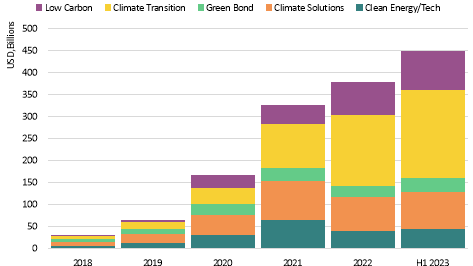
Investors drive explosive growth in climate funds but zero stocks are fully aligned
The number of open-ended and exchange-traded investment vehicles with a climate theme has experienced an explosive growth in the last five years, with investments surging by more than 30% to $534 billion in the last 18 months alone, according to new data shared with Net Zero Investor.
Climate-focused investors now have more choices than ever. Funds with climate-related mandates have risen from fewer than 200 in 2018 to more than 1,400 as of June 2023.
Fuelled by higher investor interest and regulation, Europe remains the largest and most diverse climate fund market, accounting for 84% of global assets, Morningstar data showed.
China and the United States rank second and third, with 8% and 6% market share, respectively.
European investors, primarily pension funds and insurance firms, favour climate transition funds; they account for almost half of all climate fund assets in Europe.
While other regions are warming up to these strategies, climate solutions, clean energy and clean tech funds continue to dominate the landscape outside of Europe.
No alignment
But despite the rapid expansion of products on offer, none of the most common companies in climate funds are aligned to 1.5-degree Celsius, Morningstar warned. The most popular stocks in broad market climate portfolios are more misaligned than those in portfolios that target climate solutions, with average Implied Temperature Rises of 3.3°C versus 2.4°C.
This can be explained by the high and difficult-to-manage carbon emissions coming from the supply chain and/or customers, Scope 3 upstream and downstream, of top companies in broad market portfolios, the researchers found.
"These funds reveals a gloomy reality, though. None are aligned with the goal of limiting global warming to 1.5-degree Celsius."

"Funds offering exposure to climate solutions exhibit high carbon intensity though. These funds tend to invest in transitioning companies that operate in high-emitting sectors, such as utilities, energy, and industrials, and that are developing solutions to help reduce their own emissions and those of others," Morningstar wrote in its report.
Product development in climate funds has slowed down this year in line with the broader fund market.
“The growth of climate-related funds over the past five years is simply remarkable and reflects the growing awareness of the investment risks and opportunities arising from climate change," explained Hortense Bioy, global director of sustainability research at Morningstar.
“These funds reveals a gloomy reality, though. None are aligned with the goal of limiting global warming to 1.5-degree Celsius," she continued.
"We’re not saying climate funds are greenwashing. The fact is that they’re investing in a tiny pool of companies and countries on track or close to being on track to achieve net zero emissions by 2050.”
Also read
CPPIB’s green investment chief: ‘decarbonising a portfolio at scale is almost impossible’




